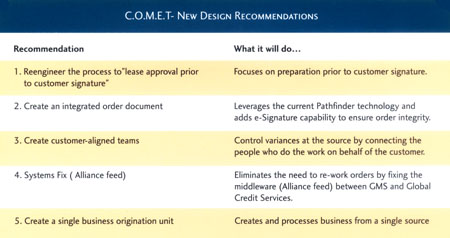
Fix The Basics
Leader - Fall 2002 - Pitney Bowes
"Fix the Basics" resonates throughout Pitney Bowes: it's the urgent call to repair customer-facing and related processes. A fundamental strategic imperative under the stewardship of Mark Davis, Vice President, Customer Service, Fix the Basics is an integrated approach designed to add value for our customers.
Along with Genesis and Voyager, C.O.M.E.T. (Customer Orders Made Easy Today) is a core fix-the-basics project. With a focus on the end-to-end order process, from marketing programs to first cash application, a key principle for the C.O.M.E.T. team is to eliminate variances at the source and get the job done right the first time.
ERP Analyst JoAnne O'Boy explains what's behind the acronym C.O.M.E.T: "We must improve our processes and make it easy for customers to do business with us; quick, fast and efficient like a comet. Meeting customer expectations and delivering shareholder value is the centerpiece for driving C.O.M.E.T. design efforts. Customers tell us they like our products and our people. Now, we need to improve the order process to complete this positive customer experience."
How Does C.O.M.E.T. Make Orders Easier?
Because of the amount of variability in our end-to-end order process, the time it takes to complete an order from customer signature to install is 19 days for average orders. In order to deliver shareholder and customer value, we need to do a much better job in the fundamentals of our business. A minimum 25 percent of work done today by employees on the end-to-end order process involves correcting variances or is non-value added.
"By minimizing variability at the source, not only can we improve the efficiency of the process, we can put more focus on the competitive work of our organization," says Dave Thomas, Project Leader. Competitive work means work that creates an advantage and/or value for which a customer will pay. With this in mind, the C.O.M.E.T. team is chartered to:
- Enhance the customer experience; thereby increasing the percentage of customers who pay their first invoice on time;
- Increase the percentage of perfect orders;
- Reduce order processing time;
- Increase sales and service capacity by eliminating variances.
Customer Value: What A Difference A Day Makes...
"Meeting customer expectations and delivering value creates a customer experience that promotes satisfaction and loyalty," explains Dave Thomas. "When a customer pays their first invoice on time, it is one indicator that we have done our job well. A recent analysis revealed that only 56% of our customers pay their first lease invoice on time. This is clearly a downstream result of an end-to-end process that needs fixing."
The C.O.M.E.T. team is approaching the new design in four phases. The first phase focuses on improving the "customer signature-to-lease approval process." Currently, it takes an average 12 days from the time a customer signs an order to when the lease is approved and the order is ready for shipping. By implementing five elements of a new design, the C.O.M.E.T. team believes that this process would be capable of achieving one day cycle time from customer signature to lease approval. (See chart: New Design Recommendations.)
How C.O.M.E.T. Provides Value
Whenever there are exceptions or variances in any process it takes energy (time and money) to manage them. The C.O.M.E.T. team believes that 25% (possibly more) of the cost of an order is related to variability. By minimizing variability, Pitney Bowes can positively impact shareholder value by reducing the cost of an order.
"The energy our company saves by minimizing variability can be channeled towards delivering customer value. Process reengineering and minimizing variances at the source are exactly what our organization needs to do prior to implementing enabling technology," explains Dave. "This is precisely why the C.O.M.E.T. project is closely linked to Voyager because of the process redesign. The benefits of this project are clearly focused on optimizing process efficiencies and at the same time channeling the power of Pitney Bowes to consistently deliver customer value."
C.O.M.E.T. Implementation
This article was featured in Leader. Currently, the C.O.M.E.T. team has completed many fixes on the Alliance feed and is piloting many components of the design elements. The customer-aligned team has been active for several months in the New England Division with some very encouraging results. The team meets daily for 15 minutes in a "Situation-at-a-Glance" call, which is facilitated by Ed Williams, Manager, Sales Structure. Daily measures are reviewed and customer situations are discussed and resolved. Cycle time for the pilot districts has improved dramatically and is currently averaging 4 - 5 days.
Nick Hage, District Director, Providence, RI, says, "Fifteen minutes a day saves hours." Dan Gilligan, District Director, Hartford, CT, says, "I have been with Pitney Bowes for 18 years and this is the best example of team work across disciplines that I have ever seen." In addition, all sales representatives in the pilot districts are equipped with e-Signature pads. Over the next several months, additional design components will be implanted. These include pre-credit authorization and enhancements to the single-business origination unit.
"The district directors and employees involved have become much more knowledgeable about the end-to-end order process of how Pitney Bowes works. As a result, we are creating greater value for our customers, becoming more efficient, and providing better service in a more enjoyable work environment," concludes Dave Thomas.



